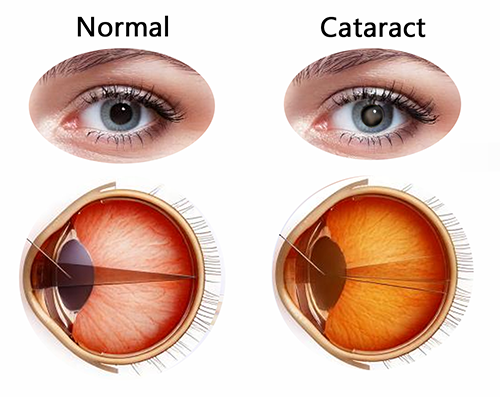What Are Cataracts?
Cataracts occur when the natural lens of your eye becomes cloudy, leading to a decrease in vision. This cloudiness can develop slowly or rapidly but is most commonly associated with aging.

Types of Cataracts:
-
Age-related cataracts: Develop as part of the normal aging process.
-
Congenital cataracts: Present at birth or in early childhood, often due to genetic factors or infections during pregnancy.
-
Secondary cataracts: Result from other medical conditions like diabetes, or from long-term use of certain medications.
-
Traumatic cataracts: Following an eye injury.
Symptoms of Cataracts:
-
Blurred or dimmed vision
-
Difficulty with night vision or seeing in low light
-
Sensitivity to glare, especially from headlights or bright sunlight
-
Seeing “halos” around lights
-
Frequent changes in eyeglass or contact lens prescription
-
Fading or yellowing of colors
Example Image:[Image showing the difference between a normal eye lens and one with a cataract, with a visual representation of how each might affect vision]
Risk Factors:
-
Age
-
Family history of cataracts
-
Long-term exposure to ultraviolet light
-
Diabetes
-
Smoking
-
Excessive alcohol consumption
-
Previous eye injury or inflammation
-
Prolonged use of corticosteroid medications
Diagnosis:
We diagnose cataracts through:

-
Visual acuity test: Measures how well you see at various distances.
-
Slit-lamp examination: Allows us to examine the structures at the front of your eye, including the lens.
-
Retinal exam: After dilating your pupils, to check for signs of cataracts and other eye conditions.
Treatment:
Surgery: The primary treatment for cataracts that impair your daily activities.
-
Phacoemulsification: Most common method, where the clouded lens is broken up by ultrasound, then removed and replaced with an artificial lens (IOL).
-
Extracapsular cataract extraction: For very advanced cataracts, where the lens is removed in one piece through a larger incision.
Pre-Surgery:
-
Comprehensive eye exam to plan the surgery and choose the right IOL.
-
Discussion about lens options, including monofocal, multifocal, or toric lenses.
Post-Surgery:
-
Quick recovery with immediate vision improvement in most cases.
-
Use of eye drops to help healing and prevent infection.
-
Follow-up visits to ensure proper healing and vision correction.
Prevention and Management:
-
Regular eye exams to monitor cataract development.
-
Protection from UV rays with sunglasses.
-
Healthy lifestyle choices like not smoking, controlling diabetes, and eating a diet rich in antioxidants.
Why Choose Us?
-
Expert care with the latest technology in cataract surgery.
-
Personalized treatment plans considering your lifestyle and vision needs.
-
Commitment to your eye health before, during, and after surgery.
